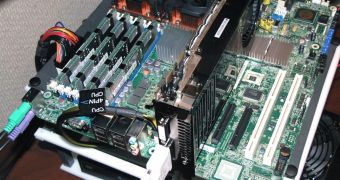Intel's V8 platform sounds more like a bad-ass car than computer related hardware, but nevertheless, it had to be something with great resonance, in order for it to be a capable match for AMD's 4x4 monster. On the first look the V8 resembles very much with the current server motherboards, and has the same kind of layout that AMD uses on its platform. Similarities aside, their architectures are very different, as Intel is still hooked on the FSB, and actually made things worse by adding two quad-core processors in the game, while AMD has the integrated memory controller which allows for faster information exchange between the processor cores, system memory and the HyperTransport technology.
HotHardware.com got their hands on a pair of Intel Xeon X5365 processors, alongside a S5000XVN dual-socket motherboard, 4GB of DDR2-667 FBDIMMs and a GeForce 8800GTX. To my surprise, Intel's motherboard didn't use only solid capacitors on its PCB; the ones that were present merely surrounded the CPU's VRM and were nowhere to be seen once you crossed the northbridge line. That means that Intel is very confident in those motherboards capabilities, although it would have been a nice touch if they were all solid.
The processors were clocked by default at 3GHz each, sporting a 1333MHz FSB, and the testing was done on the Windows XP Professional SP2, with the latest drivers. In SiSoft Sandra's Processor Arithmetic benchmark, the processors scored 110346 MIPS on Dhrystone ALU and 74180 MFLOPS on the Whetstone iSSE3 tests. When it came to Integer performance, it scored 660338 it/s, while the floating point performance test scored 358533 it/s. Compared to the results that AMD's quad-core Agena processor got against the QX6800, you can see the difference. However, such a platform is dedicated to the enthusiast segment, so is the 4x4, and Intel already announced plans of having another enthusiast platform, so the future of the V8 could have been cut short by nobody other than Intel, themselves. Hopefully, the new platform will live up to their expectations.

 14 DAY TRIAL //
14 DAY TRIAL //